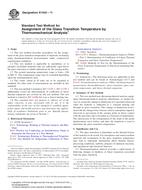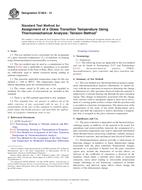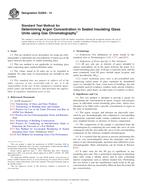Potřebujeme váš souhlas k využití jednotlivých dat, aby se vám mimo jiné mohly ukazovat informace týkající se vašich zájmů. Souhlas udělíte kliknutím na tlačítko „OK“.
ASTM C912-93(2013)
Standard Practice for Designing a Process for Cleaning Technical Glasses
Automaticky přeložený název:
Standardní praxe pro návrh Postup pro čištění technická skla
NORMA vydána dne 1.10.2013
Informace o normě:
Označení normy: ASTM C912-93(2013)
Poznámka: NEPLATNÁ
Datum vydání normy: 1.10.2013
Kód zboží: NS-15608
Počet stran: 7
Přibližná hmotnost: 21 g (0.05 liber)
Země: Americká technická norma
Kategorie: Technické normy ASTM
Kategorie - podobné normy:
Anotace textu normy ASTM C912-93(2013) :
Keywords:
cleaning, glass, solubility, solvents, technical, ICS Number Code 81.040.01 (Glass in general)
Doplňující informace
| Significance and Use |
|
3.1 Many of the low-silica technical glasses which contain soluble or reactive oxides require processing or involve applications that require cleaning. Very often these cleaning procedures have evolved over several decades and are considered an art. They usually contain numerous steps, some of questionable validity. It is the premise of this practice that cleaning glass can be more scientific. Design of a cleaning procedure should involve (1) a definition of the soil to be removed, (2) an awareness of the constraints imposed by the glass composition, and (3) a rational selection of alternative methods that will remove the soil and leave the glass in a condition suitable for its intended application. This practice provides information to assist in step (1.1 This practice covers information that will permit design of a rational cleaning procedure that can be used with a glass that is somewhat soluble in many aqueous chemical solutions. Typically, this type of glass is used in applications such as optical ware, glass-to-metal seals, low dielectric loss products, glass fibers, infrared transmitting products, and products resistant to metallic vapors. 1.2 In most cases, this type of glass contains high concentrations of oxides that tend to react with a number of aqueous chemicals. Such oxides include B2O3, Al2O3, R2O, RO, La2O3, ZnO, PbO, P2O5, and Fe2O3. The more conventional high-silica glasses are usually more chemically resistant, but the cleaning principles outlined here also apply to them. 1.3 This standard does not purport to address all of the safety concerns, if any, associated with its use. It is the responsibility of the user of this standard to establish appropriate safety and health practices and determine the applicability of regulatory limitations prior to use. Specific hazard statements are given in Section 4 and Table 1. |
Podobné normy:
Historická
1.3.2012
Historická
1.4.2011
Historická
1.8.2013
Historická
1.12.2011
Historická
1.11.2010
Historická
1.4.2014
Doporučujeme:
Aktualizace technických norem
Chcete mít jistotu, že používáte pouze platné technické normy?
Nabízíme Vám řešení, které Vám zajistí měsíční přehled o aktuálnosti norem, které používáte.
Chcete vědět více informací? Podívejte se na tuto stránku.



 ASTM C1351M-96(2012)..
ASTM C1351M-96(2012).. ASTM E1545-11
ASTM E1545-11 ASTM E1824-13
ASTM E1824-13 ASTM E1967-11a
ASTM E1967-11a ASTM E2188-10
ASTM E2188-10 ASTM E2269-14
ASTM E2269-14
 Cookies
Cookies
